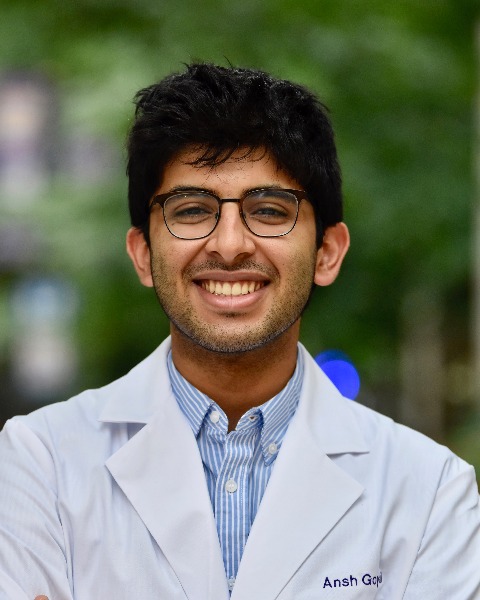Public Health & Prevention
Category: Abstract Submission
Public Health & Prevention II
576 - Addressing the Impact of Pediatric Gun Violence Exposure in an Urban Pediatric Primary Care Setting
Saturday, April 23, 2022
3:30 PM - 6:00 PM US MT
Poster Number: 576
Publication Number: 576.241
Publication Number: 576.241
Ansh Goyal, Northwestern University Feinberg School of Medicine, Chicago, IL, United States; Patricia Z. Labellarte, Ann & Robert H. Lurie Children's Hospital of Chicago, Chicago, IL, United States; Ashley Hayes, Ann & Robert H. Lurie Children's Hospital of Chicago, Chicago, IL, United States; J.C. Bicek III, Lawndale Christian Health Center, Kingsport, TN, United States; Leonardo Barrera, Ann & Robert H. Lurie Children's Hospital of Chicago, Chicago, IL, United States; Adam B. Becker, Northwestern University The Feinberg School of Medicine, Chicago, IL, United States; Bruce Rowell, Lawndale Christian Health Center, Chicago, IL, United States; Audrey G. Brewer, Northwestern University Feinberg School of Medicine, Ann & Robert H. Lurie Children's Hospital of Chicago, Chicago, IL, United States

Ansh Goyal
Medical Student
Northwestern University Feinberg School of Medicine
Chicago, Illinois, United States
Presenting Author(s)
Background: Gun violence is a preventable public health epidemic that dramatically impacts the lives of youth and families. Youth exposed to gun violence are at increased risk for negative health outcomes over the life course.
Objective: To explore integration of a modified gun violence risk tool into a pediatric intake form for youth (12-17 years) at Lawndale Christian Health Center (LCHC), a federally qualified health care center on the West Side of Chicago, to identify risk of gun violence exposure, and to implement a gun violence intervention referral process connecting at-risk youth to community programs.
Design/Methods: Research experts and gun violence community-based organizations in Chicago (BUILD Inc., UCAN, and New Life Centers) modified the ‘SaFETy’ gun violence exposure tool, previously studied in an Emergency Department (ED) setting to identify gun violence risk exposure and predict future gun violence behavior among youth. A referral protocol for positively screened youth was developed and implemented during annual preventive well child checks (WCC) (June-Aug 2021). All pediatric clinicians were surveyed post-pilot and patients were randomly selected to complete an engagement survey after their WCC.
Results: In the study period, 341 patients (median age 14 years) completed the SaFETy screening tool, Table 1. Most youth were Hispanic (58.9%) or non-Hispanic black (37.8%). About 40.1% of patients had one or more mental/behavioral health diagnoses and 56% had one or more existing physical health diagnoses. No patient had a SaFETy score ≥ 6, the threshold for immediate referral, Table 2. Over one quarter of patients (26.4%) had a score of 1-5, and of those 7.8% were referred at the clinician’s discretion. In a random anonymous survey collected in a locked drop-box, 91.7% (77/84) reported finding the questions very easy to understand and 98.8% of respondents (83/84) reported answering the screening questions honestly, Figure 1. All 6 clinicians surveyed agreed or strongly agreed that the questionnaire helped identify patients at risk to gun violence exposure who otherwise would not have been identifiedConclusion(s): It is feasible to screen for gun violence exposure among youth, but a more sensitive tool in the primary care setting is necessary. The LCHC gun violence intervention and prevention referral program may be a model for other urban primary care to connect at-risk youth to community resources. Additional work exploring the trauma, and physical and mental health symptoms associated with gun violence exposure among youth in the primary care setting is needed.
APA Student Research Award CV - Ansh GoyalGoyal_Ansh_CV_2021_12_18_21.pdf
Table 2. SaFETy Screening Scores Among Adolescents Screened for Gun Violence Exposure.jpg)
Objective: To explore integration of a modified gun violence risk tool into a pediatric intake form for youth (12-17 years) at Lawndale Christian Health Center (LCHC), a federally qualified health care center on the West Side of Chicago, to identify risk of gun violence exposure, and to implement a gun violence intervention referral process connecting at-risk youth to community programs.
Design/Methods: Research experts and gun violence community-based organizations in Chicago (BUILD Inc., UCAN, and New Life Centers) modified the ‘SaFETy’ gun violence exposure tool, previously studied in an Emergency Department (ED) setting to identify gun violence risk exposure and predict future gun violence behavior among youth. A referral protocol for positively screened youth was developed and implemented during annual preventive well child checks (WCC) (June-Aug 2021). All pediatric clinicians were surveyed post-pilot and patients were randomly selected to complete an engagement survey after their WCC.
Results: In the study period, 341 patients (median age 14 years) completed the SaFETy screening tool, Table 1. Most youth were Hispanic (58.9%) or non-Hispanic black (37.8%). About 40.1% of patients had one or more mental/behavioral health diagnoses and 56% had one or more existing physical health diagnoses. No patient had a SaFETy score ≥ 6, the threshold for immediate referral, Table 2. Over one quarter of patients (26.4%) had a score of 1-5, and of those 7.8% were referred at the clinician’s discretion. In a random anonymous survey collected in a locked drop-box, 91.7% (77/84) reported finding the questions very easy to understand and 98.8% of respondents (83/84) reported answering the screening questions honestly, Figure 1. All 6 clinicians surveyed agreed or strongly agreed that the questionnaire helped identify patients at risk to gun violence exposure who otherwise would not have been identifiedConclusion(s): It is feasible to screen for gun violence exposure among youth, but a more sensitive tool in the primary care setting is necessary. The LCHC gun violence intervention and prevention referral program may be a model for other urban primary care to connect at-risk youth to community resources. Additional work exploring the trauma, and physical and mental health symptoms associated with gun violence exposure among youth in the primary care setting is needed.
APA Student Research Award CV - Ansh GoyalGoyal_Ansh_CV_2021_12_18_21.pdf
Table 2. SaFETy Screening Scores Among Adolescents Screened for Gun Violence Exposure
.jpg)
